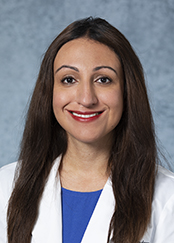New Treatment Options for Headaches
Date
January 6, 2022

Date
January 6, 2022
Credits
Medical providers featured in this article
In Brief
{{cta-block}}
Migraines, the third most-common illness globally, affect 39 million people in the U.S. and can be as devastating as they are prevalent. They are responsible for about 1.2 million emergency room visits each year, and more than 90% of sufferers experience head pain and neurological symptoms so severe they can't work or function, according to the Migraine Research Foundation.
They have also been on the rise amid the stress and disruption of the COVID-19 pandemic.
While the condition frequently goes undiagnosed, you don't have to suffer in silence, even if you've tried to treat your headaches before to no avail.
"It's an exciting time in headache medicine," says neurologist Dr. Nasima D. Shadbehr, who recently launched a specialized headache clinic at Cedars-Sinai.
New treatments have revolutionized the field over the past two years and have vastly expanded the possibilities—and hope—for most migraine sufferers whose symptoms don't improve using traditional medications.
{{providers}}
Monoclonal antibodies
This new class of migraine-prevention therapies target the calcitonin gene-related peptide (CGRP) pathway, a protein linked to migraine symptoms. One medication (erenumab) blocks the CGRP docking station (receptor), while the others inhibit CGRP itself. Patients can self-administer monthly injections of Aimovig (erenumab), Emgality (galcanezumab) or the third drug, Ajovy (fremanezumab, which can be injected monthly or quarterly), while another similar antibody option—Vyepti (eptinezumab)—is delivered as a quarterly IV infusion.
Gepants and ditans
Another newer group of drugs targets the same molecule but is provided orally. These medications, include Ubrelvy (ubrogepant), Nurtec (rimegepant) and Atogepant (Qulipta). Ubrelvy is used to help treat acute migraines, while Qulipta is used for migraine prevention. And Nurtec can be used for both. The Food and Drug Administration approved the most recent, atogepant (Qulipta), in September 2021.
Lasmiditan (Reyvow) is a separate type of treatment that targets the serotonin receptors on brain nerve endings to halt migraine attacks as they occur.
The ability to take Nurtec both for prevention and acute treatment implies that it does not have the same overuse limitations as existing drugs, Dr. Shadbehr notes.
Providers suggest taking acute headache treatments no more than 10 days each month, because overindulging in either over-the-counter drugs or triptans can cause headaches. Medication overuse underlies many cases of episodic migraines that become chronic.
"For people finding they need to take a lot of breakthrough medications, gepants would be a good option because they're less likely to develop rebound headaches," she says.
"There is a lot of room for future study with these medicines that will expand our ability to use them and better understand them"
Benefits and risks
These innovations open the door for migraine patients with heart disease, stroke and vascular diseases, who couldn't safely take the older class of triptan migraine medications. They could also be a game-changer for those who experienced the long list of side effects (or didn't find relief) on other drugs such as triptans, antidepressants, and seizure or blood pressure medications, especially people with refractory migraines who feel they have "run out of options," Dr. Shadbehr says.
Additionally, patients on this new class of drugs are able to get onto a full dose earlier than the adjustment period required to test your reaction and build up to classic headache medications.
There are caveats: Patients need to try other treatments before insurance will approve one of the new ones. Lasmiditan comes with a warning of no driving for at least eight hours after taking a dose. Gepant pills have some drug interactions to watch out for, and one antibody therapy (erenumab) carries a risk of constipation and increased blood pressure.
At this time, these medications are considered unsafe for pregnant women, who remain a major gap in headache care.
"There is a lot of room for future study with these medicines that will expand our ability to use them and better understand them," Dr. Shadbehr says.
Botox and trigger point injections
These relatively recent, effective options can be used on their own or in conjunction with other treatments.
Botox is FDA-approved for chronic migraines in adults who have at least 15 headache days a month with each headache lasting four or more hours. The series includes at least 31 injections across and around the head and shoulders.
Treatments are repeated once every three months, Dr. Shadbehr says, and most patients see a decrease in headache days after the first two sessions. Because they rely on the same botulinum toxin as cosmetic Botox procedures, side effects can be similar and include some muscle weakness. But Botox is usually a well-tolerated treatment option.
For patients who hold stress and tension in their shoulders and neck, the different aches and pains are interconnected.
"It becomes a pain cycle," Dr. Shadbehr says.
Trigger point injections target muscles to address co-occurring myofascial and chronic neck and shoulder pain, and nerve blocks address concurrent neuralgias and help break up frequent headache cycles.
Treating the bigger picture often helps improve headache discomfort, she adds.
Crafting a holistic care plan
If you're experiencing painful migraines or other types of severe or chronic headaches, see your primary care doctor or a neurologist. They can refer you to a headache specialist for specialized care such as injections.
These tools are just one part of a larger headache strategy.
Lifestyle changes are also key, Dr. Shadbehr says. Getting enough sleep, hydrating and limiting caffeine can all ease headache symptoms. Keeping a migraine diary can also help you and your provider identify your patterns and personal food triggers.
There are individualized treatment plans available to help alleviate chronic headaches and improve your quality of life.






